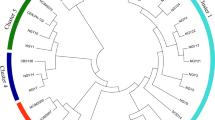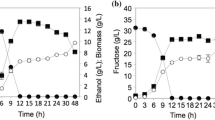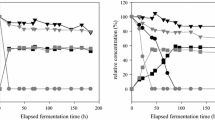Abstract
Nineteen yeast isolates retrieved from molasses and grapes were studied for tolerance to temperature, ethanol and sugar along with optimization of fermentation parameter and ethanol production using different carbon sources. All the isolates were able to grow up to 40 °C temperature. Total 11 isolates, i.e., M1, M5, M6, M7, M8, M11, M12, M15, M18, M19 and G1 tolerated 18–20% (w/v) glucose, while isolates M1, M2, M5, M12, M15 and M20 were able to tolerate 12–15% (v/v) ethanol. Maximum 1.72 g/100 gsubstrate/h ethanol productivity, using 15% (w/v) glucose at 30 °C, was obtained in case of isolate M12 followed by 1.37, 1.29, 1.25 and 1.20g/100 gsubstrate/h by isolates M3, M6, M5 and M15, respectively. Total eight promising isolates were selected for optimization of fermentation parameters. The temperature shift from 30 to 35 °C, increased ethanol production in case of all the isolates by a factor ranging from minimum 8.85% in isolate M3 to maximum 26.22% in isolate M7. Isolate M15 showed 8.43% (v/v) ethanol at 35 °C as compared to 7.25% (v/v) at 30 °C. Maximum ethanol production was achieved at pH 4.8 in all the promising isolates which was decreasing with increasing pH from 4.8 to 5.5 and above. Isolate M20 produced 9.30% ethanol with molasses as compared to 8.1% (v/v) achieved using pure glucose as carbon source under optimized conditions. Maximum 10.72% and 9.65% (v/v) ethanol were produced by isolate M20 using hydrolysates of rice and wheat, respectively. Appearance of 101.51% fermentation efficiency during bioconversion of rice hydrolysate into ethanol by isolate M20 clearly indicated the occurrence of simultaneous saccharification and fermentation.




Similar content being viewed by others
References
Aguilera, F., R.A. Peinado, C. Millan, J.M. Ortega, and J.C. Mauricio. 2006. Relationship between ethanol tolerance, H+-ATPase activity and the lipid composition of the plasma membrane in different wine yeast strains. International Journal of Food Microbiology 110: 34–42.
Alexandre, H., I. Rousseaux, and C. Charpentier. 1994. Ethanol adaptation mechanisms in Saccharomyces cerevisiae. Biotechnology and Applied Biochemistry 20: 173–183.
AOAC. 1975. Official methods of analysis. Washington, DC: Association of Analytical Chemists.
Brooks, A.A. 2008. Ethanol production potential of local yeast strains isolated from ripe banana peels. African Journal of Biotechnology 7(20): 3749–3752.
Caspeta, L., Y. Chen, P. Ghiaci, A. Feizi, S. Buskov, and B.M. Hallström. 2014. Altered sterol composition renders yeast thermotolerant. Science 346(6205): 75–78.
Caspeta, L., Y. Chen, and J. Nielsen. 2016. Thermotolerant yeasts selected by adaptive evolution express heat stress response at 30 °C. Scientific Reports 6: 27003. https://doi.org/10.1038/srep27003.
Chatterjee, S., B. Ghosh, and R.R. Ray. 2011. Isolation and characterization of local yeast strains from waste fruit juices, jaggery and dahi samples. International Journal of Chemical Sciences 9(2): 647–656.
Galeote, V., B. Blondin, S. Dequin, and J. Sablayrolles. 2001. Stress effect of ethanol on fermentation kinetics by stationary-phase cells of Saccharomyces cerevisiae. Biotechnology Letters 23(9): 677–681.
Gasmalla, M.A.A., R. Yang, M. Nikoo, and S. Man. 2012. Production of ethanol from Sudanese sugar cane molasses and evaluation of its quality. Journal of Food Processing and Technology 3(7): 163. https://doi.org/10.4172/2157-7110.1000163.
Hacking, A.J., L.W.F. Taylor, and C.M. Hamas. 1984. Selection of yeast able to produce ethanol from glucose at 40 °C. Applied Microbiology and Biotechnology 19: 361–363.
Kajiwara, S., K. Suga, H. Sone, and K. Nakamura. 2000. Improved ethanol tolerance of Saccharomyces cerevisiae strains by increases in fatty acid unsaturation via metabolic engineering. Biotechnology Letters 22: 1839–1843.
Olowonibi, O.O. 2017. Isolation and characterization of palm wine strains of Saccharomyces cerevisiae potentially useful as bakery yeasts. European Journal of Experimental Biology 7: 11. https://doi.org/10.21767/2248-9215.100011.
Osho, A. 2005. Ethanol and sugar tolerance of wine yeasts isolated from fermenting cashew apple juice. African Journal of Biotechnology 4(7): 660–662.
Qvirist, L.A., C. De Filippo, F. Strati, I. Stefanini, M. Sordo, T. Andlid, and D. Cavalieri. 2016. Isolation, identification and characterization of yeasts from fermented goat milk of the Yaghnob Valley in Tajikistan. Frontiers in Microbiology 7: 1690.
Sangwan, S., S. Gupta, P. Singh, and N. Chawla. 2014. Fuel ethanol production from molasses by indigenous yeast isolates. Sugar Tech 16(4): 422–429.
Sharma, N., K.L. Kalra, H.S. Oberoi, and S. Bansal. 2007. Optimization of fermentation parameters for production of ethanol from kinnow waste and banana peels by simultaneous saccharification and fermentation. Indian Journal of Microbiology 47: 310–316.
Thammasittirong, S.N.R., T. Chamduang, U. Phonrod, and K. Sriroth. 2012. Ethanol production potential of ethanol-tolerant Saccharomyces and non-Saccharomyces yeasts. Polish Journal of Microbiology 61(3): 219–221.
Tikka, C., H.P. Osuru, N. Atluri, P.C.V. Raghavulu, N.K. Yellapu, I.S. Mannur, and M. Bhaskar. 2013. Isolation and characterization of ethanol tolerant yeast strains. Bioinformation 9(8): 421–425.
Togarepi, E., N. Mapiye, C. Muchanyereyi, and P. Dzomba. 2012. Optimization of fermentation parameters for ethanol production from Ziziphus mauritiana fruit pulp using Saccharomyces cerevisiae (NA33). International Journal of Biochemistry Research and Review 2(2): 60–69.
You, K.M., C. Rosenfield, and D.C. Knipple. 2003. Ethanol tolerance in the yeast Saccharomyces cerevisiae is dependent on cellular oleic acid content. Applied and Environmental Microbiology 69(3): 1499–1503.
Author information
Authors and Affiliations
Corresponding author
Rights and permissions
About this article
Cite this article
Sangwan, S., Sharma, M.K., Kumar, V. et al. Potential Hexose Fermenting Yeast for Conversion of Sugary and Starchy Raw Materials into Ethanol. Sugar Tech 21, 320–328 (2019). https://doi.org/10.1007/s12355-018-0688-x
Received:
Accepted:
Published:
Issue Date:
DOI: https://doi.org/10.1007/s12355-018-0688-x




